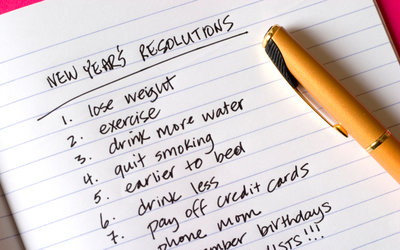Can’t Think of a Fitness Resolution? Try One of Ours!
With New Year’s Eve just around the corner, now is the time to take a look at what you want for your wellbeing. Do you wish you could burn more fat? Or do your aims lie in building more muscle or gaining flexibility? If you’re struggling to think of what you want to do to take your wellness to the next level, or you don’t know what to do in order to achieve your goals, we’ve got the five most common fitness goals, as well as the expert advice you need to reach them.
1. Burning More Fat: According to Scott Weiss, DPT, ATC, CSCS, a New York based physical therapist and athletic trainer, you need to burn more calories overall if you want to burn more fat. The way to burn a higher percentage of fat calories is to take up long, slow distance exercise, but if you kick up the intensity you can burn the highest total number of calories and total fat overall. The “afterburn” effect of interval training – also known as excess post oxygen consumption (EPOC) – helps you to burn more calories, so Weiss recommends alternating 20-30-second sprints for every five minutes of running at your normal pace.
2. Running Faster: Whether you want to beat your friend in the next 10K or just top your personal best, you need to improve your stride length and frequency (or the distance you take with each step and how fast your legs move. Founder of Inspire Training Systems Neal Pire, CSCS, author of Plyometrics for Athletes At All Levels, explains, ‘Ultimately, running speed is based on the product of stride length and stride frequency. This involves increasing the strength and power of your hip extensors, especially your glutes and hamstrings.’ For this you need squats, step-ups, single-leg Romanian squats and calf-strengthening moves in your workout.
3. Lifting Heavier Weights: Pire notes that gaining strength requires two things: pushing yourself past your comfort zone and using weight that fatigues you at no more than six reps. Research suggests that doing two to six sets of six repetitions, and having two- to five-minute rest periods in between each set, will get you the best results. Pire adds, ‘Get rest between sets so that you can repeat your performance the following set.’
4. Increasing Your Endurance: Strengthening your heart, increasing your ability to uptake oxygen in the muscles and dealing with the by-products of exercise such as lactic acid is essential if you want to win out against your athletic opponents. Weiss notes, ‘You want to use a combo of long slow distance and high intensity interval training (HIIT)…Not only does HIIT help strengthen the heart muscle, but it stimulates a greater uptake of oxygen in working muscle. Plus, the more hydrated you are, the less likely you are to feel a burn while you work out – so drink up.’
5. Improving Your Agility: When you’re agile, this translates into dodging puddles on a rainy day or sidestepping a hole in the pavement when walking or running. Weiss comments, ‘Agility is the ability to start, stop and change direction efficiently.’ To improve your agility, Weiss recommends ladder drills, the 5-10-5 football shuttle test and figure-eight cone drills along with box jumps for advanced exercisers.
6. Increasing Flexibility: There are four kinds of stretching in which you need to take part if you want to increase your flexibility. Firstly, you need to take up static stretching, or lengthening a muscle and holding it for 30 seconds and focusing on one specific muscle. For passive stretching, you need to use a strap, gravity, body weight or another person to apply force while you relax. Then you need to incorporate PNF (proprioceptive neuromuscular facilitation) stretching, which involves a relax and contract method often used by athletes. Finally, Weiss recommends two to three sets of 20 dynamic stretches, which ‘includes multiple muscles and joints and provides the best crossover for exercise and sport.’


Comments are closed.